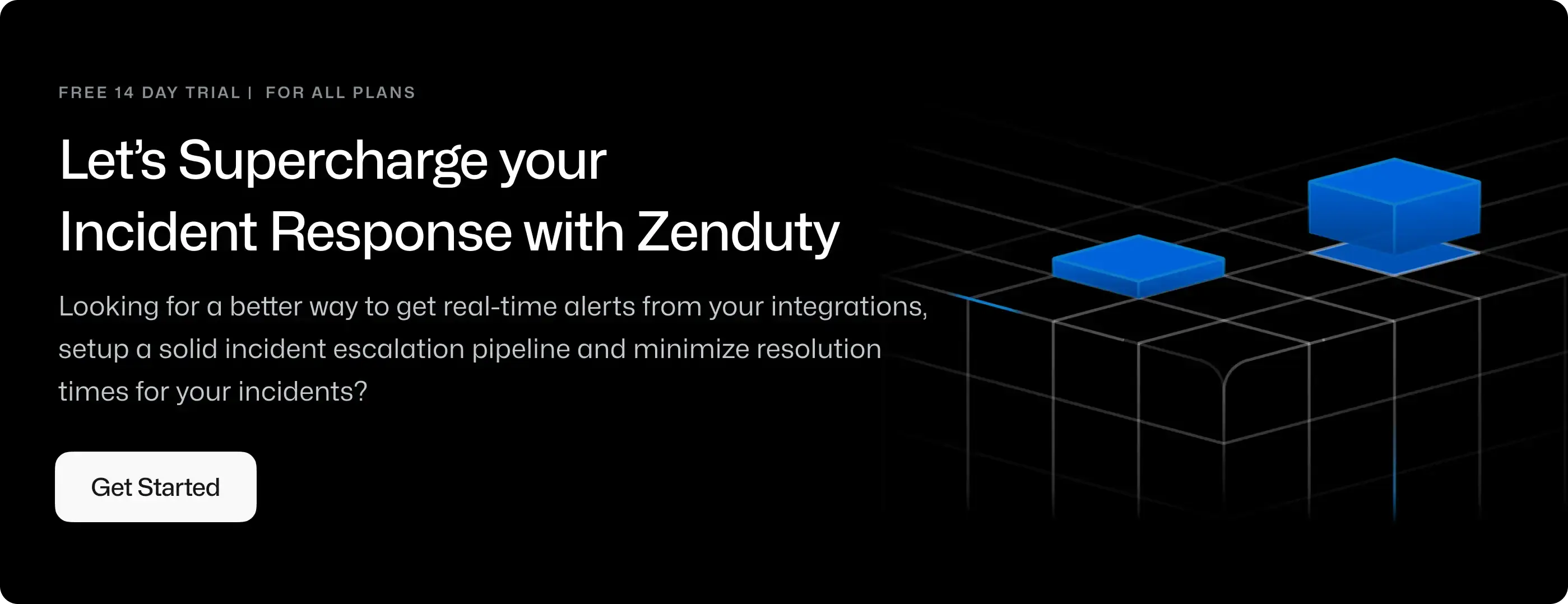Freshdesk Two-way Integration Guide
Freshdesk is an online cloud-based customer service software providing helpdesk support with all smart automations to get things done faster.
What can Zenduty do for Freshdesk users?
With the Freshdesk(Outgoing) Integration, Zenduty sends new ticket alerts to the right support engineer or team and notifies them based on on-call schedules via email, text messages(SMS), phone calls(Voice), Slack, Microsoft Teams and iOS & Android push notifications, and escalates alerts until the alert is acknowledged or closed. Zenduty provides your support engineers with detailed context around the Freshdesk ticket alert along with support playbooks and a complete incident command framework to triage and remediate and resolve incidents with speed.
Whenever a ticket is created in Freshdesk, Zenduty will create an incident. When the ticket status is updated to Pending, Zenduty will auto-ackknowledge the incident. When the ticket is resolved on Freshdesk, Zenduty will auto-resolve the ticket.
Two way capability:
When an incident is acknowledged on Zenduty, the ticket on Freshdesk will be marked as Pending. When an incident is resolved on Zenduty, the ticket on Freshdesk will be marked as Resolved.
You can also use Alert Rules to custom route specific Freshdesk alerts to specific support engineers, staff, teams or escalation policies, write suppression rules, auto add notes, responders and incident tasks.
To integrate Two-Way Freshdesk with Zenduty, complete the following steps:
On the Zenduty Dashboard:
-
To add a new Freshdesk integration, go to Teams on Zenduty and click on the team you want to add the integration to.
-
Next, go to Services and click on the relevant Service.
-
Go to Integrations and then Add New Outgoing Integration. Give it a name and select the application Freshdesk(two-way) from the dropdown menu.
-
Go to Configure under your integrations to edit it.
-
Open a new tab and to your Freshdesk page and copy your API token from the My Profile Settings page.

-
Go back to the Zenduty Freshdesk(two-way) settings tab, and under Domain name, enter your Freshdesk domain name. For example, if your Freshdesk URL is acme.freshdesk.com, then your domain name is acme.
-
Click Next to Authenticate your credentials.

-
Next, select which configuration you want the integration to be in,
- From Freshdesk to Zenduty
This makes it so that any Ticket created on Freshdesk will create an Incident on Zenduty. - From Zenduty to Freshdesk
This makes it so that any Incident created by that service on Zenduty, will generate a ticket on Freshdesk.
-
Proceed to map the Incident response for the configuration selected from above. This will determine what action will change the ticket status and vice versa with Zenduty incident statuses.
-
Proceed to map the Incident response from Zenduty to FreshDesk and from FreskDesk to Zenduty. This will determine what action will change the ticket status and vice versa with Zenduty incident statuses.

-
Copy the generated Webhook URL to be applied onto FreshDesk.
-
Then click Save Integration.
In Freshdesk:
-
Log into Freshdesk. Click on the Admin button and select Automations under Helpdesk Productivity Settings.

-
Click on the Create the first rule button.

-
Select New Rule and pick Rule Name and Description. Set Conditions as:
- Type Is Incident

- Type Is Incident
-
Select Trigger Webhook from the Actions dropdown, and set Request Type to POST.
-
Under the URL, paste the webhook url you copied earlier.
-
Set the Encoding as JSON and content as Simple.
-
Under Content, select the following fields- Ticket ID, Subject, Description, Status, Ticket URL.(As shown in the screenshot below.)

-
-
Save.
-
From the same window, move to Ticket Updates sections and click on New Rule button.

-
Select New Rule and pick a Rule Name and Description.
- Set When an Action Performed By to Agent or Requester. Then set Involved any of these events for Status is Changed from Any Status to Any Status.
-
In the On tickets with these properties section, set condition as Type Is and Incident.

-
Select Trigger Webhook from the Actions dropdown and set the Request Type to POST.
-
In the URL textbox, paste the webhook link you copied earlier.
-
Set the Encoding to JSON and Content to Simple.
-
Under Content, Select fields - Ticket ID, Subject, Description, Ticket Status and Ticket URL.(As shown in the screenshow below.)

-
-
Save.
Your Freshdesk(two-way) integration is now complete!

